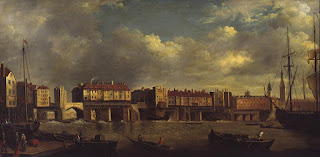The Stories Behind London’s Streets (Book 1)
The streets of London flourish like possibly no other city
on earth, with stories from its rich history, stories of death - fire -
disease, of riots, and grisly murders, but also of tales of happiness,
determination and success. Behind every story and every street however, are the
people who lived, worked, played, and even murdered there.
In 1777, Dr. Samuel Johnson wrote the following about London:
"Sir, if you wish to have a just notion of the
magnitude of this city, you must not be satisfied with seeing its great streets
and squares, but must survey the innumerable little lanes and courts. It is not
in the showy evolutions of buildings, but in the multiplicity of human
habitations which are crowded together, that the wonderful immensity of London
consists"
Everyone thinks they know of the legend of Dick Turpin, the gentleman highway robber, but Turpin was far from being the gentleman he was portrayed as. During one robbery, when he and his gang broke into an elderly widow’s house, Turpin hoisted the poor woman’s skirts and held her over the open fire until she screamed with pain and finally relented into telling him where her money was hidden. While this was going on, two members of his gang were raping the poor woman’s young daughter.
How many people also know anything about the small, insignificant looking “ventilation shaft” in Took’s Court, which is just around the corner to Chancery Lane and Lincoln's Inn? The ‘Daily Worker’ investigated it on 8th September 1951 and reported that it was the entrance to an atom bomb proof citadel that the Government was building. At the height of the Cuban missile crisis in 1962 the complete complex was put under lock and key for a fortnight. No staff were allowed in or out during this period but other people certainly were, including the then Prime Minister, Harold Macmillan and other members of his Cabinet. Most people today think of the Cuban missile crisis, solely as a standoff between the USSR and the USA, but according to well-placed Soviets, the Russian premier, Nikita Khrushchev had placed London as first on his list, to be hit by a nuclear attack from Russia. Looking at that small, insignificant looking “ventilation shaft” today in Took’s Court, it is difficult to put into perspective, the important role it played during those near fatal two weeks in 1962 when this country came so close to Armageddon.
History isn’t just about digging up artefacts from the dim and distant past, history happens every day. It happened yesterday, and most people never even noticed it.
Read more here: https://www.amazon.co.uk/The-Stories-Behind-Londons-Streets-ebook/dp/B005DLM4BY
Everyone thinks they know of the legend of Dick Turpin, the gentleman highway robber, but Turpin was far from being the gentleman he was portrayed as. During one robbery, when he and his gang broke into an elderly widow’s house, Turpin hoisted the poor woman’s skirts and held her over the open fire until she screamed with pain and finally relented into telling him where her money was hidden. While this was going on, two members of his gang were raping the poor woman’s young daughter.
How many people also know anything about the small, insignificant looking “ventilation shaft” in Took’s Court, which is just around the corner to Chancery Lane and Lincoln's Inn? The ‘Daily Worker’ investigated it on 8th September 1951 and reported that it was the entrance to an atom bomb proof citadel that the Government was building. At the height of the Cuban missile crisis in 1962 the complete complex was put under lock and key for a fortnight. No staff were allowed in or out during this period but other people certainly were, including the then Prime Minister, Harold Macmillan and other members of his Cabinet. Most people today think of the Cuban missile crisis, solely as a standoff between the USSR and the USA, but according to well-placed Soviets, the Russian premier, Nikita Khrushchev had placed London as first on his list, to be hit by a nuclear attack from Russia. Looking at that small, insignificant looking “ventilation shaft” today in Took’s Court, it is difficult to put into perspective, the important role it played during those near fatal two weeks in 1962 when this country came so close to Armageddon.
History isn’t just about digging up artefacts from the dim and distant past, history happens every day. It happened yesterday, and most people never even noticed it.
Read more here: https://www.amazon.co.uk/The-Stories-Behind-Londons-Streets-ebook/dp/B005DLM4BY

Comments
Post a Comment